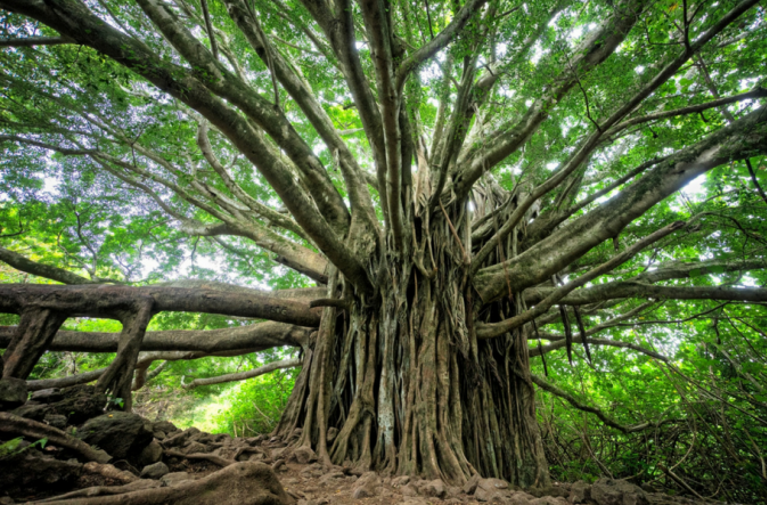It’s safe to say that life would not be the same without trees. In fact, all human civilisation is dependent upon them. Not only as a source of valuable resources, but also for the ecological benefits they provide – called ecosystem services. We all know trees are awesome, but most people don’t quite understand all the important things they do.
I’m sure you know the basic stuff:
- Trees produce oxygen, which we need to breathe
- They absorb carbon dioxide, helping us fight climate change
- They produce timber, firewood and paper
- They provide a habitat for wildlife
But do you know that trees are also a natural flood defence? Or that they help to block out excess noise? Or that patients heal quicker if they have a view of trees? Here’s 8 amazing benefits of trees that might be new to you.
8 amazing benefits of trees I bet you don’t know about*
1. Trees prevent floods

Flooding happens after heavy rain when rivers burst their banks or drainage systems overflow. Trees can help prevent this by absorbing much of the excess water before it flows into drains or rivers. The surface roots quickly absorb water as it seeps into the ground and the deep tap roots use up some of the groundwater, allowing the soil to absorb more.
As well as simply drinking a lot of water, trees also change the physical structure of the soil. The dropped leaves and twigs add organic matter, which allows the soil to hold more water – and the little microbes that eat them create tiny tunnels in the soil, helping water seep in more effectively.
This recent study says strategic tree-planting can reduce the ‘peak height’ of floods in downstream towns by up to 20%.
2. Trees ALSO prevent droughts

Maybe it’s not that surprising that trees are a natural flood defence, because they drink a lot of water. But get this: they also help to prevent droughts.
Trees and forests play a vital role in the water cycle. As well as drinking water through their roots, they release water through their leaves into the air – a process called transpiration. And they catch rain on their leaves, which evaporates back into the air to form rainclouds – although often the wind carries them and the rain falls somewhere else. Almost half of all rainfall is driven by this combined process of evapotranspiration by forests. Tree cover is around twice as efficient at this than agricultural land.
With more research, it may even be possible to increase rainfall to arid regions by strategic tree-planting in other places, using wind currents to transport the water vapour to where it’s needed most. This could be a gamechanger as climate change gets more serious.
3. Trees prevent soil erosion and landslides

Soil erosion is probably the most unsexy environmental problem, but it’s a huge problem nonetheless. Half the world’s topsoil has been lost in the last 150 years.
Strong wind and rain can wash away the nutrient-rich topsoil, reducing soil fertility. This is a nightmare for agriculture, and it gets even worse: the topsoil is often washed into streams and rivers, where the vital resource becomes a pollutant, as it clogs up waterways and the high levels of nitrogen poisons aquatic life. Trees prevent this sorry state of affairs by physically holding the soil in place with their roots. Trees also protect the ground from the elements, shielding it from the wind and rain.
This is particularly crucial on hillsides, where erosion is more serious (thanks gravity) and can even cause dangerous landslides.
Extensive soil erosion eventually leads to land degradation and the spread of barren deserts, but trees can stop that process in its tracks. The Great Green Wall is a bold project to plant a forest all the way across the width of Africa to halt the spread of the Sahara Desert.
4. Trees boost soil fertility

The way trees regulate water and hold the soil together makes the soil better for growing crops, but it doesn’t stop there. They also boost soil fertility. You might think they would use up the nutrients, leaving less available for other plants – but trees are just too awesome not to be a net benefit. As they drop leaves and twigs, they decompose, feeding beneficial microbes and insects. All this organic matter is basically natural fertiliser. In turn it attracts more plants and wildlife and they make the soil even richer, powering a virtuous circle.
5. Trees help to buffer noise

Trees are even a natural form of sound proofing. They absorb and scatter sound waves, like anything that blocks their path. But they’re much more attractive than a screen, wall or mound of earth, and the gentle sounds of rustling leaves and swaying branches also helps to mask the unwanted noise. A dense belt of trees between something noisy and people who don’t want to hear it can reduce the noise pollution by several decibels. The effect is even stronger if combined with hedges and mounds of earth.
This could be an effective urban planning tool to limit the issue of noise around things like schools, microfactories and nightclubs.
6. Trees cool down hot cities

Cities tend to be a few degrees warmer than the surrounding rural areas, due to something called the urban heat island effect. That probably doesn’t sound too bad, especially if you live in the rather soggy UK like me, but it causes health problems and even deaths in the summer and increases energy demand for air conditioning – which bumps up costs and causes more carbon emissions. In the US, excess heat causes more deaths than hurricanes, floods and lightning combined.
Grey buildings and roads absorb more light than green vegetation does, emitting more heat and warming up the city. Urban trees (along with gardens, parks, green walls and greenroofs) counter this through the power of evapotranspiration. Their leaves release water vapour, cooling the surrounding air. Of course, trees also provide shade.
7. They make people happier, healthier and more productive

Trees have been shown to boost people’s health and wellbeing, and the effect is not entirely explained by their air-cleaning oxygen-giving properties.
If like me you find trees soothing, you’re not alone, and science explains it’s more than a warm fuzzy feeling. Studies show looking at trees and green plants calms the central nervous system, reduces cortisol (the stress hormone), slows the heart rate and lowers blood pressure. Interestingly, even looking at photos of trees has some effect.
Patients that have a view of trees outside their window actually heal faster. The calming effect reduces stress and pain, allowing the patient’s immune system to function more effectively. Similarly, studies have shown workers to be more productive when they have views of nature.
No one knows exactly how trees and nature has this physical and psychological effect on us, but the biophilia hypothesis holds that humans crave nature because that’s how we evolved over millennia, with urban lifestyles being ridiculously recent and unnatural by comparison.
8. Trees provide livelihoods for billions of people

In a way, you and everyone else are dependent on trees, because of the vital ecosystem services we’ve just been discussing, not to mention products made from wood. But while you and me have so many indirect links to the forest, for many people around the world forests and trees are a direct lifeline. A massive 1.6 billion people are directly reliant on forests for their livelihood, according to the FAO.
Mostly in developing countries, these people depend on forest resources in three main ways: using wild food, wood and medicinal plants for regular household consumption, selling such products for income or using wild food as a safety net when crops fail. This last point is crucial for protecting people from hunger in countries that often lack a proper welfare state.
As you can see, trees have so many amazing properties that can help us not only reduce climate change but also adapt to its inevitable impacts – while making life better at the same time. That’s the kind of multifaceted solution I like. If you’re feeling a newfound love for trees, here’s some things you can do.
What you can do
- When buying paper products (notebooks, toilet rolls, birthday cards…) choose ones with the FSC symbol. Or better yet, recycled.
- Ask your local representative to plant more urban trees in your area
- Give to charities like The Woodland Trust or American Forests
- Take part in a tree planting session
- Share this post to encourage people to think about the many benefits of trees
* If you already knew all eight of these, then congratulations: you win. Unfortunately The Climate Lemon is, um, fresh out of prizes…
So what do you think are the coolest benefits of trees? Did I miss something? Let me know in the comments or on Twitter at @TheClimateLemon. And if you liked this post, subscribe now to get the next ones straight to your inbox!






